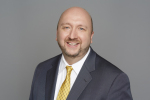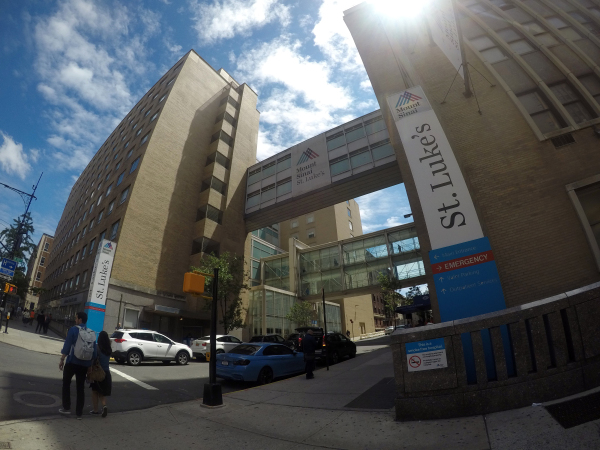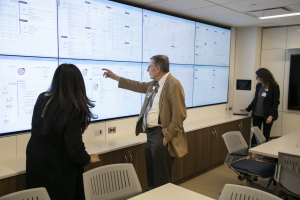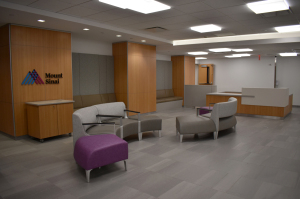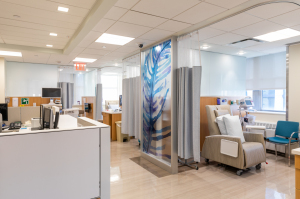Q & A with Art Gianelli, president of Mount Sinai St. Luke’s
September 02, 2019
by Sean Ruck, Contributing Editor
HealthCare Business News spoke with Arthur A. Gianelli, MBA, MPH, president of Mount Sinai St. Luke’s, to get the details his unique background brings to his role, and to hear his insight about the hospital and healthcare overall.
HCB News: What inspired you to pursue a career in healthcare?
AG: My path was not a traditional one. I worked for a significant time in local government: first, as a director of operations for a town, then as a deputy county executive for budget and finance. My expertise was in finance, turnaround management and strategic planning.
While I was deputy county executive, I was approached by the consultants the county had hired to help develop a strategic plan for its affiliated public hospital. The hospital was chronically challenged, financially and otherwise. The consultants wanted me to run the hospital. I laughed. I told them I had not run a hospital before, I’d been successful in my career, but that’s a challenge not like any other. And no one had been successful historically in running that hospital. However, the more I thought about it, I believed in the hospital’s mission and the population it served and I decided to look at it as a real opportunity. I decided to take a chance and go for it. I advised the consultants that they needed to persuade my wife, who was adamantly opposed to this, being very familiar with the hospital and its history. But they were able to persuade her as well.
I took the leap and started my tenure. Given the constraints we were under and the challenges facing that institution, I think we did really remarkable work in terms of improving quality and safety and starting to recover the finances of the hospital. We also reinvested in the hospital in ways that hadn’t been done previously. We also encouraged the staff to believe that transformation was possible. And finally, I joined a number of boards across the country. I was on the executive committee of America’s Essential Hospitals, the regional policy board for the American Hospital Association, the executive committee for Healthfirst. My goal was to gain knowledge and insight into running a hospital. Now, I actually teach hospital operations at Columbia University and at Mount Sinai. I’m proud of that, because it wasn’t too long ago that I was just embarking on a career as a healthcare administrator.
HCB News: How long have you been with Mount Sinai St. Luke’s?
AG: I’ve been with the Mount Sinai Health System since February 2014.
HCB News: What attracts staff to Mount Sinai St. Luke’s?
AG: Similar to my prior hospital, Mount Sinai St. Luke’s needed a turnaround strategy. That was very clear to the leadership at Mount Sinai and that was my charge here at St. Luke’s. There’s been well over $100 million of capital investment to build an ambulatory platform, to upgrade equipment, to replace the EMR, to transform the appearance and operation of the organization. There have also been investments in the hiring of staff to cover gaps in our hospital service, and we’ve hired staff to keep up with the volume growth that’s occurred. We’ve targeted certain services to expand and grow — cardiology, cardiac surgery, bariatric surgery, orthopedic trauma, cancer and our geriatric program.
Staff are attracted to the opportunity to work for the Mount Sinai Health System. They are also attracted to working for a hospital whose services are growing and increasing in complexity. Mount Sinai St. Luke’s is a Lean hospital. When I first came to Mount Sinai, I advised Dr. Ken Davis, the president of the Mount Sinai Health System, that my experience of running a hospital was through a Lean framework and that’s what I wanted to do here at St. Luke’s. He was absolutely encouraging. From day one, that’s what we’ve done here. We’ve used Lean to develop our daily management system, for process improvement and to galvanize and energize the culture.
It’s evident to anyone who comes here, that the experience of working at St. Luke’s is different than at other hospitals. Here, the wisdom of the frontline staff is valued and cultivated. We want our frontline workers to be emissaries of problem solving. I think people who are attracted to that and that level of agency with respect to their work, really want to come here. We also try to emphasize the tenets of a just culture. Errors, when they do occur, are typically associated with system and process failures. What we’re not trying to do is create a culture of blame, we’re creating a culture where we can examine our failures and do so honestly and transparently in a way that’s not pointing fingers at our employees, but instead identifying processes that can be fixed and improved.
HCB News: Can you tell us roughly what the makeup of your patients is from a payor perspective?
AG: About 85 percent of the patients that receive care at Mount Sinai St. Luke’s are insured by the government, either through Medicaid or Medicare. Any hospital that has that ratio of government to commercial payors is going to have challenges. Part of our strategy is to develop and grow programs that can diversify our payor mix. Certain services have diversified quite nicely. Our bariatric surgery, as an example, has seen our payor mix change significantly from an overwhelmingly government payor mix to one that is balanced. It’s a small part of our business, but important. We have to identify other services that can help us diversify the types of patients and payors that come here. It’s challenging, but important work.
HCB News: Our interview is taking place in June, which was designated as Pride month a decade ago. I saw on the Mount Sinai website in the “about us” a section dedicated to LGBT Health. The section is extensive and also shows LGBT champions dating back to 2015. Were there any challenges to being able to position Mount Sinai as an LGBT advocate?
AG: That’s an interesting question. I will tell you that the Mount Sinai Health System is fully committed to LGBTQ care and to advocacy on behalf of LGBTQ patients. That ranges from specific programs we offer — one of our hospitals is a center for excellence for transgender surgery — to the approach we take with respect to patients who arrive at our hospitals. There’s training we do systemwide with our frontline staff regarding pronoun usage, respecting the desires of our patients regarding how they identify themselves and how they want to be identified by their caregivers. I think that’s part and parcel to the value Mount Sinai places on patients and employees.
It’s also part and parcel to the history of our hospitals. Mount Sinai was founded in 1852 for people who were Jewish at a time when the Jewish residents of New York couldn’t get care at certain hospitals. So there’s a long history of Mount Sinai identifying with and seeking to support people who have been historically oppressed or discriminated against. That’s also another reason I’m really proud to be part of this system.
We see all sorts of patients that are at the margins of society and we believe very strongly it’s our responsibility and obligation to stand up for them and ensure that they receive the best level of care.
HCB News: What else do you think is unique about Mount Sinai?
AG: I would say that the staff is not only second to none, but they are really culturally unique. It’s a very family-oriented organization. That’s evident in terms of how staff interact with each other and how they interact with patients.
In terms of services, the main growth area for St. Luke’s since the merger with Mount Sinai has been in cardiology and cardiac surgery. Every element of our cardiology and cardiac surgery programs has grown significantly over the last five years. We have world-class physicians leading the way. It’s a remarkable transformation since I first got here, and we’ve seen remarkable growth while maintaining the highest possible level of quality and safety. Mount Sinai St. Luke’s is also a long-standing trauma center with stellar orthopedic trauma surgeons who have grown their practice significantly over the last several years.
We have a solid general surgery program which includes our trauma program, but also includes vascular and bariatric surgery as well as surgical oncology. The System Chief of Surgical Oncology is also the Chairman of Surgery for Mount Sinai St. Luke’s and Mount Sinai West. We are thoughtfully and carefully expanding our cancer program. Last year, we opened an infusion suite and we’re hiring additional clinicians to provide targeted medical and surgical oncologic services.
We’re installing a PET CT through the generosity of a grant secured by our New York City councilman, Mark Levine. And finally, we’re privileged to be hosting the geriatric program from Mount Sinai, since this program is ranked by US News and World Report as the third best geriatric program in the country.
HCB News: Healthcare is an ongoing problem both in the political arena and in the actual practice of delivering care, due to continually rising costs, coordination of care, etc. If you had one wish for something you could introduce to help solve the problem, is there something that comes to mind?
AG: I would like to have two wishes. First, I think the macro political debate that we’re having — should we have single payor, fix the ACA, do something else? — misses the point. The challenge right now is how do we deliver really good healthcare to our patients that is both affordable and can be sustained by our healthcare delivery system? I would argue that the “Medicare for All” debate is a false debate because it suggests that the way we’re going to address the cost of care is through the government dictating what will be paid for health care services. I’m concerned about that price point being set at a level that’s not sufficient to sustain the quality of services we need to provide to patients.
The real debate should be about how we can organize the delivery system in a way that reduces waste significantly such that we can change the trajectory of health care costs. Some estimates have pegged the waste generated by our health care delivery system at $750 billion annually. One of the reasons we’re committed to Lean at Mount Sinai St. Luke’s is because its focus is the elimination of waste and the introduction of value to the patient through innovation.
The second wish I would make — and it’s one of the things I talk about at Mount Sinai — is about our ability to innovate. The types of discoveries and the science that’s happening here at Mount Sinai, it makes me immensely proud to be part of it in my small way. But we, as an industry, need to innovate for the day-to-day with the same enthusiasm and urgency that we apply to finding a cure for cancer. Patients need to experience a health care delivery system that is seamless, integrated, connected, clear and understandable. We need to do that. We need to innovate at that level. There are places in the country that do it well. I think Mount Sinai is on the way to doing it well. We need to foster that type of commitment to day-to-day innovation and improvement throughout the health system in the United States. If we could do that, we would begin to impact cost, wring out waste and change how healthcare is delivered. My fear is that our political debate obscures this reality — where the real action should be occurring. My hope would be that we change what we talk about to talk about this.
HCB News: What inspired you to pursue a career in healthcare?
AG: My path was not a traditional one. I worked for a significant time in local government: first, as a director of operations for a town, then as a deputy county executive for budget and finance. My expertise was in finance, turnaround management and strategic planning.
While I was deputy county executive, I was approached by the consultants the county had hired to help develop a strategic plan for its affiliated public hospital. The hospital was chronically challenged, financially and otherwise. The consultants wanted me to run the hospital. I laughed. I told them I had not run a hospital before, I’d been successful in my career, but that’s a challenge not like any other. And no one had been successful historically in running that hospital. However, the more I thought about it, I believed in the hospital’s mission and the population it served and I decided to look at it as a real opportunity. I decided to take a chance and go for it. I advised the consultants that they needed to persuade my wife, who was adamantly opposed to this, being very familiar with the hospital and its history. But they were able to persuade her as well.
I took the leap and started my tenure. Given the constraints we were under and the challenges facing that institution, I think we did really remarkable work in terms of improving quality and safety and starting to recover the finances of the hospital. We also reinvested in the hospital in ways that hadn’t been done previously. We also encouraged the staff to believe that transformation was possible. And finally, I joined a number of boards across the country. I was on the executive committee of America’s Essential Hospitals, the regional policy board for the American Hospital Association, the executive committee for Healthfirst. My goal was to gain knowledge and insight into running a hospital. Now, I actually teach hospital operations at Columbia University and at Mount Sinai. I’m proud of that, because it wasn’t too long ago that I was just embarking on a career as a healthcare administrator.
HCB News: How long have you been with Mount Sinai St. Luke’s?
AG: I’ve been with the Mount Sinai Health System since February 2014.
HCB News: What attracts staff to Mount Sinai St. Luke’s?
AG: Similar to my prior hospital, Mount Sinai St. Luke’s needed a turnaround strategy. That was very clear to the leadership at Mount Sinai and that was my charge here at St. Luke’s. There’s been well over $100 million of capital investment to build an ambulatory platform, to upgrade equipment, to replace the EMR, to transform the appearance and operation of the organization. There have also been investments in the hiring of staff to cover gaps in our hospital service, and we’ve hired staff to keep up with the volume growth that’s occurred. We’ve targeted certain services to expand and grow — cardiology, cardiac surgery, bariatric surgery, orthopedic trauma, cancer and our geriatric program.
Staff are attracted to the opportunity to work for the Mount Sinai Health System. They are also attracted to working for a hospital whose services are growing and increasing in complexity. Mount Sinai St. Luke’s is a Lean hospital. When I first came to Mount Sinai, I advised Dr. Ken Davis, the president of the Mount Sinai Health System, that my experience of running a hospital was through a Lean framework and that’s what I wanted to do here at St. Luke’s. He was absolutely encouraging. From day one, that’s what we’ve done here. We’ve used Lean to develop our daily management system, for process improvement and to galvanize and energize the culture.
John D. Puskas, M.D., chair of Cardiovascular Surgery at Mount Sinai St. Luke's and Mount Sinai West, and Gianluca Torregrossa, M.D., perform the Mount Sinai Health System's first TECAB surgery.
HCB News: Can you tell us roughly what the makeup of your patients is from a payor perspective?
AG: About 85 percent of the patients that receive care at Mount Sinai St. Luke’s are insured by the government, either through Medicaid or Medicare. Any hospital that has that ratio of government to commercial payors is going to have challenges. Part of our strategy is to develop and grow programs that can diversify our payor mix. Certain services have diversified quite nicely. Our bariatric surgery, as an example, has seen our payor mix change significantly from an overwhelmingly government payor mix to one that is balanced. It’s a small part of our business, but important. We have to identify other services that can help us diversify the types of patients and payors that come here. It’s challenging, but important work.
HCB News: Our interview is taking place in June, which was designated as Pride month a decade ago. I saw on the Mount Sinai website in the “about us” a section dedicated to LGBT Health. The section is extensive and also shows LGBT champions dating back to 2015. Were there any challenges to being able to position Mount Sinai as an LGBT advocate?
AG: That’s an interesting question. I will tell you that the Mount Sinai Health System is fully committed to LGBTQ care and to advocacy on behalf of LGBTQ patients. That ranges from specific programs we offer — one of our hospitals is a center for excellence for transgender surgery — to the approach we take with respect to patients who arrive at our hospitals. There’s training we do systemwide with our frontline staff regarding pronoun usage, respecting the desires of our patients regarding how they identify themselves and how they want to be identified by their caregivers. I think that’s part and parcel to the value Mount Sinai places on patients and employees.
Screens in the new Daily Management and Incident Command Center display real-time data for areas throughout the hospital, enabling staff to track patients during their stay and monitor flow, admissions, discharges, and other clinical operations.
We see all sorts of patients that are at the margins of society and we believe very strongly it’s our responsibility and obligation to stand up for them and ensure that they receive the best level of care.
HCB News: What else do you think is unique about Mount Sinai?
AG: I would say that the staff is not only second to none, but they are really culturally unique. It’s a very family-oriented organization. That’s evident in terms of how staff interact with each other and how they interact with patients.
In terms of services, the main growth area for St. Luke’s since the merger with Mount Sinai has been in cardiology and cardiac surgery. Every element of our cardiology and cardiac surgery programs has grown significantly over the last five years. We have world-class physicians leading the way. It’s a remarkable transformation since I first got here, and we’ve seen remarkable growth while maintaining the highest possible level of quality and safety. Mount Sinai St. Luke’s is also a long-standing trauma center with stellar orthopedic trauma surgeons who have grown their practice significantly over the last several years.
We have a solid general surgery program which includes our trauma program, but also includes vascular and bariatric surgery as well as surgical oncology. The System Chief of Surgical Oncology is also the Chairman of Surgery for Mount Sinai St. Luke’s and Mount Sinai West. We are thoughtfully and carefully expanding our cancer program. Last year, we opened an infusion suite and we’re hiring additional clinicians to provide targeted medical and surgical oncologic services.
We’re installing a PET CT through the generosity of a grant secured by our New York City councilman, Mark Levine. And finally, we’re privileged to be hosting the geriatric program from Mount Sinai, since this program is ranked by US News and World Report as the third best geriatric program in the country.
HCB News: Healthcare is an ongoing problem both in the political arena and in the actual practice of delivering care, due to continually rising costs, coordination of care, etc. If you had one wish for something you could introduce to help solve the problem, is there something that comes to mind?
AG: I would like to have two wishes. First, I think the macro political debate that we’re having — should we have single payor, fix the ACA, do something else? — misses the point. The challenge right now is how do we deliver really good healthcare to our patients that is both affordable and can be sustained by our healthcare delivery system? I would argue that the “Medicare for All” debate is a false debate because it suggests that the way we’re going to address the cost of care is through the government dictating what will be paid for health care services. I’m concerned about that price point being set at a level that’s not sufficient to sustain the quality of services we need to provide to patients.
The new Infusion Suite at Mount Sinai St. Luke's serves as an extension of the highly regarded Tisch Cancer Institute at The Mount Sinai Hospital.
The second wish I would make — and it’s one of the things I talk about at Mount Sinai — is about our ability to innovate. The types of discoveries and the science that’s happening here at Mount Sinai, it makes me immensely proud to be part of it in my small way. But we, as an industry, need to innovate for the day-to-day with the same enthusiasm and urgency that we apply to finding a cure for cancer. Patients need to experience a health care delivery system that is seamless, integrated, connected, clear and understandable. We need to do that. We need to innovate at that level. There are places in the country that do it well. I think Mount Sinai is on the way to doing it well. We need to foster that type of commitment to day-to-day innovation and improvement throughout the health system in the United States. If we could do that, we would begin to impact cost, wring out waste and change how healthcare is delivered. My fear is that our political debate obscures this reality — where the real action should be occurring. My hope would be that we change what we talk about to talk about this.
